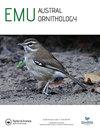Trends in breeding activity of the threatened Malleefowl (Leipoa ocellata): what can we expect under a changing climate?
IF 1.1
4区 生物学
Q3 ORNITHOLOGY
引用次数: 3
Abstract
ABSTRACT Climate change is expected to significantly impact bird species through changes to breeding and survival. Malleefowl (Leipoa ocellata) are threatened mound-building birds that persist in uncleared mallee and shrubland vegetation in semi-arid parts of southern Australia. Our aim was to understand the relationship between environmental factors and mound breeding activity (a proxy for population trends) to identify likely climate change impacts and possible proactive management actions. We compared annual activity at grids that encompassed groups of mounds at six sites in South Australia for up to 24 years with a range of environmental and habitat variables, focussing on variables predicted to change with a warming climate. Mound activity declined significantly over the study period at five of the six sites. Activity was positively associated with increased cumulative rain in the previous 2 years, lower average maximum temperatures in the winter, higher-than-average Southern Oscillation Index (i.e. more rain) 2 years before breeding and greater winter vegetation cover. These results suggest that moisture and vegetation cover are important for higher breeding activity. Climate change is predicted to lead to drier conditions and more frequent fires in our study region, suggesting that Malleefowl populations will continue to decline. We urge conservation practitioners to minimise climate change impacts through implementing proactive management actions that increase habitat quality for Malleefowl: fire management to reduce the scale of fire events and controlling introduced and overabundant native herbivores to preserve vegetation cover, retain soil moisture, increase food resources and protect from temperature extremes.受威胁的马蹄铁(lepoa ocellata)的繁殖活动趋势:在不断变化的气候下我们可以期待什么?
气候变化通过改变鸟类的繁殖和生存,对鸟类产生重大影响。在澳大利亚南部半干旱地区的未开垦的沼泽和灌木植被中,有一种受威胁的土墩建造鸟类。我们的目的是了解环境因素与土堆繁殖活动(种群趋势的代表)之间的关系,以确定可能的气候变化影响和可能的主动管理措施。我们比较了南澳大利亚六个地点包含土堆群的网格的年度活动,长达24年,其中包括一系列环境和栖息地变量,重点关注预测随着气候变暖而变化的变量。在研究期间,6个地点中有5个地点的土墩活动显著下降。活动与前2年累积雨量增加、冬季平均最高气温较低、繁殖前2年南方涛动指数高于平均水平(即雨量较多)和冬季植被覆盖增加呈正相关。这些结果表明,湿度和植被覆盖是提高繁殖活动的重要因素。据预测,气候变化将导致我们研究区域的干旱条件和更频繁的火灾,这表明马蹄铁的数量将继续下降。我们敦促自然保护从业者通过实施积极主动的管理行动来减少气候变化的影响,从而提高马利灰猫头鹰的栖息地质量:通过火灾管理来减少火灾事件的规模,控制引进的和过多的本地食草动物,以保护植被覆盖,保持土壤湿度,增加食物资源,并保护它们免受极端温度的影响。
本文章由计算机程序翻译,如有差异,请以英文原文为准。
求助全文
约1分钟内获得全文
求助全文
来源期刊

Emu-Austral Ornithology
生物-鸟类学
CiteScore
2.00
自引率
7.70%
发文量
33
审稿时长
>12 weeks
期刊介绍:
Emu – Austral Ornithology is the premier journal for ornithological research and reviews related to the Southern Hemisphere and adjacent tropics. The journal has a long and proud tradition of publishing articles on many aspects of the biology of birds, particularly their conservation and management.
 求助内容:
求助内容: 应助结果提醒方式:
应助结果提醒方式:


